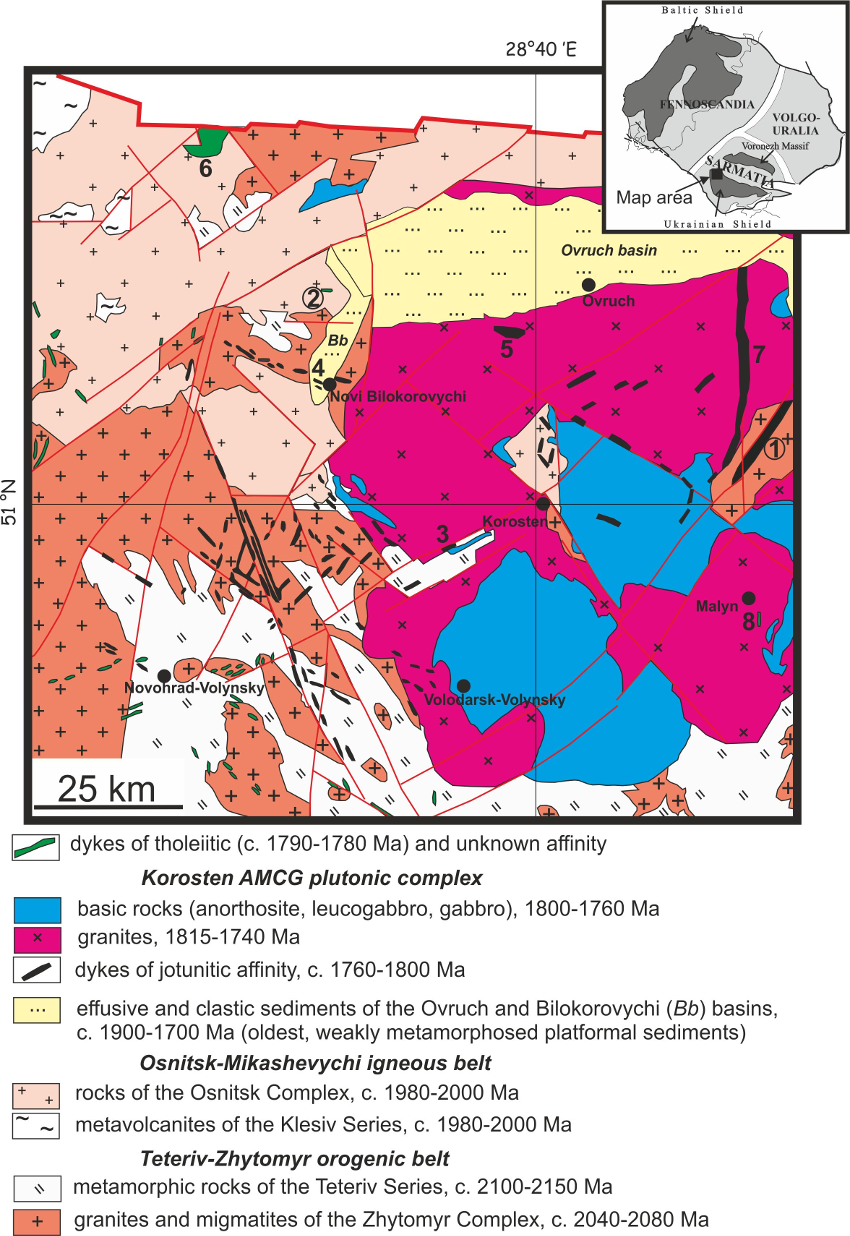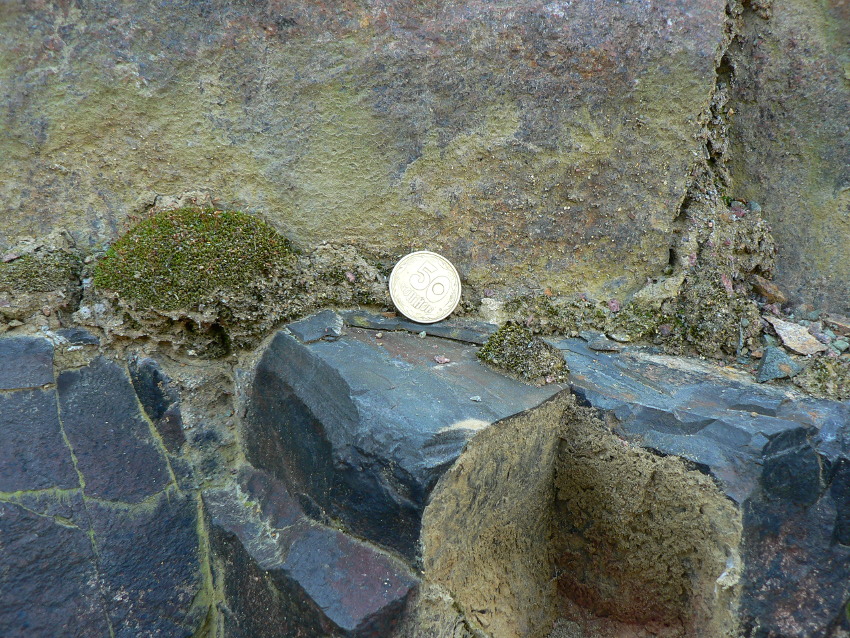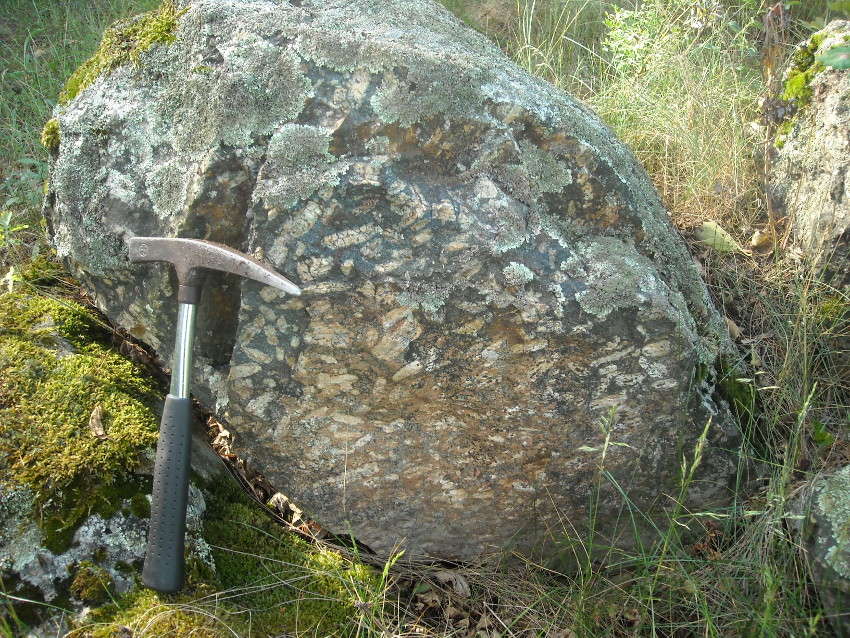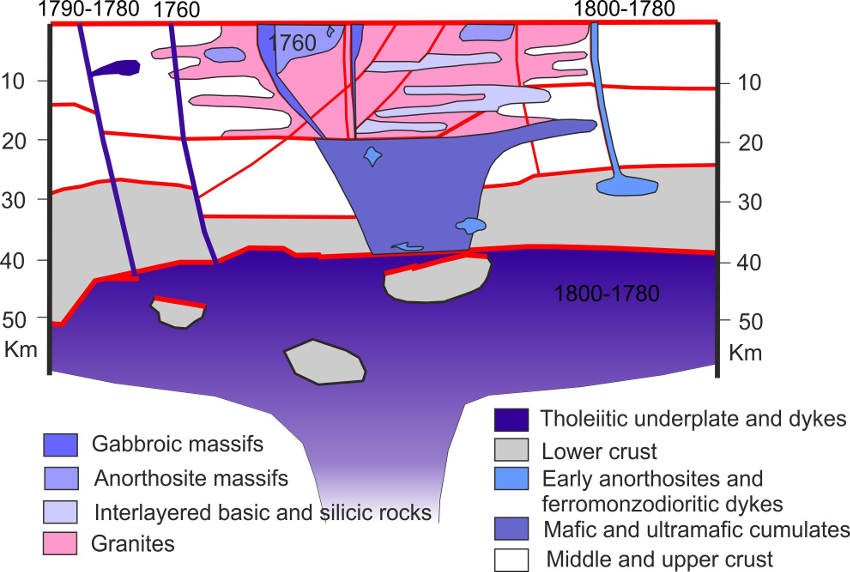January 2020 LIP of the Month
Possible Genetic Links Between Coeval Mantle-Derived Tholeiitic Magmatism and Anorthosite-Mangerite-Charnockite-Granite Complexes: 1800-1760 Ma Magmatism in the Ukrainian Shield
Leonid SHUMLYANSKYY
School of Earth and Planetary Sciences, Curtin University, Perth, GPO Box U1987, WA 6845, Australia
Leonid.Shumlyanskyy@curtin.edu.au
M.P. Semenenko Institute of Geochemistry, Mineralogy and Ore Formation, Palladina Ave., 34, 03142 Kyiv, Ukraine
Figures and text compiled from
Shumlyanskyy , Ernst R., Söderlund U., Billström K., Mitrokhin O., Tsymbal S., 2016. New U-Pb ages for mafic dykes in the Northwestern region of the Ukrainian shield: coeval tholeiitic and jotunitic magmatism. GFF, 138, 79-85.
Shumlyanskyy L., Hawkesworth C., Billström K., Bogdanova S., Mytrokhyn O., Romer R., Dhuime B., Claesson S., Ernst R., Whitehouse M., Bilan O., 2017. The origin of the Palaeoproterozoic AMCG complexes in the Ukrainian Shield: new U-Pb ages and Hf isotopes in zircon. Precambrian Research, 292, 216-239.
Duchesne J.-C., Shumlyanskyy L., Mytrokhyn O.V., 2017. The jotunite of the Korosten Plutonic Complex (Ukrainian shield): crust- or mantle-derived? Precambrian Research, 299, 58-74.
Introduction
The Ukrainian Shield hosts numerous dykes and small intrusions of variable composition (low-Ti and high-Ti dolerites, subalkaline olivine gabbro, jotunite, ultramafic alkaline rocks, high-Ti ultramafic rocks, kimberlites; Bukharev and Polyansky, 1983; Zinchenko et al., 1986; Kostenko et al., 1990; Lebedinsky, 1952; Lychak, 1954; 1983; Shumlyanskyy, 1999; Shumlyanskyy et al., 2013; 2016a; 2016c; Bogdanova et al., 2013; Duchesne et al., 2017; Tsymbal et al., 1997; 1999; 2007; 2008; 2011; 2013; Kryvdik et al., 2003; Mytrokhyn et al., 2014; 2015; 2016) that intruded between 1800 and 1760 Ma and form a part of the Paleoproterozoic Prutivka-Novogol Large igneous province (LIP), or even a larger province that comprised Sarmatia (as a part of Baltica continent), Amazonia, West Africa, and possibly some other continents. Roughly coevally with the Pritivka-Novogol LIP, two large anorthosite-mangerite-charnockite-granite (AMCG) complexes intruded in the northwestern (Korosten Complex) and central (Korsun-Novomyrhorod Complex) parts of the Ukrainian Shield (Amelin et al., 1994; Shumlyanskyy et al., 2006; 2017; Mytrokhyn et al., 2003; 2008). There are close spatial and temporal links between the AMCG complexes and mantle-derived melts that may indicate their genetic relationships. We will consider these relationships on the example of the Northwestern region of the Ukrainian Shield that hosts abundant mantle-plume-related magmatism and coeval Korosten AMCG Complex (Fig. 1).

Figure 1. Schematic geological map of the Northwestern region of the Ukrainian Shield. Numbers indicate dated intrusive bodies: 1 – Rudnya Bazarska dyke (1793 Ma, Shumlyanskyy et al., 2016a); 2 – Zamyslovychi dyke (1789 Ma, Shumlyanskyy et al., 2016a); 3 – Pugachivka dyke (1761 Ma, Amelin et al., 1994); 4 – Bilokorovychi dyke (1799 Ma, Shumlyanskyy and Mazur, 2010); 5 – Bondary sill (1751 Ma, Lubnina et al., 2009); 6 – Kamyanka massif (c. 1790 Ma, Shumlyanskyy et al., 2012). The Prutivka layered dolerite body (1777 Ma, Shumlyanskyy et al. 2012, 2016b) and the Tomashgorod dyke (1790 Ma, Shumlyanskyy et al. 2012; Bogdanova et al. 2013), are located outside of the map. Lacking geochronological data Zvizdal-Zalissya (7) and Malin (8) dykes are also shown.
Geological setting
Tholeiitic dolerites occur as numerous dykes and several layered intrusions confined to the major regional fault zones. Dykes are variable in size, their width varies from meters up to 500 m, lengths reach 12 km, and groups of dykes can be traced for 50 km and more (e.g. Tomashgorod dyke; Shumlyanskyy, 2008). Most of the tholeiitic dykes are Ni-enriched (>100 ppm Ni) and comprise olivine-pigeonite and pigeonite-augite dolerites and gabbro.
Besides, the Northwestern region of the Ukrainian shield hosts several dykes of subalkaline olivine gabbro (Shumlyanskyy, 1999), and a series of dykes and small intrusions of mafic and ultramafic alkaline rocks that belong to the Horodnytsya Complex (Tsymbal et al. 1997; 2008; Kryvdik et al. 2003).
The Korosten plutonic complex is one of the largest (about 10 400 km2) and most typical examples of AMCG complexes in the world. It embraces granitic rocks that belong to the rapakivi group, and a suite of basic rocks that includes predominantly anorthosite and leucogabbronorite, and subordinate gabbro-noritic rocks. Other volumetrically minor rock types include monzonites, syenites, and monzonitic syenites. Basic rocks form sheet-like bodies, the largest of which occupies 1250 km2, and vary in thickness from hundreds to thousands of metres. Granites of the rapakivi group are the dominant rocks at the current level of erosion, but characteristic coarse-grained wiborgitic rapakivi is rare. Medium-grained granites with sparse mantled ovoids are more common. Biotite-amphibole granites with fayalite and ferrous hedenbergite prevail near the contacts with basic rocks. Towards the central parts of the granitic massifs these turn into biotite-amphibole granite and then into amphibole-biotite granite.
Dykes of jotunitic (high-Ti ferromonzodiorite and quartz-ferromonzodiorite) affinity cut rapakivi-like granites and anorthosites of the northern and western parts of the KPC, as well as country rocks. Dykes are usually less than 10 m thick and up to few hundred metres long. There are two exceptions: the Zvizdal-Zalissya and the Rudnya Bazarska dykes (Fig. 1) occur as wide (up to 1500 m) and long (up to 18 km) high-Ti monzonitic dolerite bodies. In the Bondary open pit jotunites occur as a series of subhorizontal (sill-like) bodies up to 3-4 m thick that intrude rapakivi-like granites of the Korosten complex and have clear glassy contacts against the host granites (Fig. 2a). Jotunitic dykes are often laden with plagioclase phenocrysts (Fig. 2b) and are described in the literature under the names “plagioporphyrite” or “plagiophyric dolerite”. The chilled margins of gabbroic massifs that constitute a part of the KPC, have compositions similar to jotunitic dykes and share features that include the presence of variable amounts of K-feldspar, and correspondingly high K2O contents (0.90-3.89 %). They also have high TiO2 (1.91-3.77 %) and P2O5 (0.45-1.87 %) contents at relatively low Mg# (21-46). Concerning their chemistry, ferromonzodiorite dykes and chilled margins are broadly similar to rocks known as jotunites in other AMCG complexes worldwide (Duchesne et al., 1985; Owens et al., 1993; Robins et al., 1997; Vander Auwera et al., 1998; Wiszniewska et al., 2002). Jotunites probably represent initial melts for basic rocks of the Ukrainian AMCG complexes as can be concluded from their occurrence as chilled margins of gabbroic massifs.
Geochronological data for the jotunitic dykes is scarce. Amelin et al. (1994) have obtained a concordant age of 1760.7 ± 1.7 Ma for a plagioclase-porphyritic dolerite dyke that crops out nearby the Pugachivka village. A zircon age of 1799 ± 10 Ma was obtained for jotunitic dolerite of the Bilokorovychi dyke swarm (Shumlyanskyy and Mazur 2010). Finally, Lubnina et al. (2009) reported a U-Pb zircon age of 1751 ± 12 Ma for the Bondary jotunite sill.

Fig. 2a. Glassy contact of the Bondary jotunite sill (below the coin) with host granites

Fig. 2b. Plagiophyre jotunite dyke near the Puhachivka village
Discussion and conclusion
Geochemical and isotopic data indicate a moderately-depleted mantle source for tholeiite magmatism of the Northwestern region of the Ukrainian shield (Shumlyanskyy et al. 2012; Bogdanova et al. 2013). The melting most probably occurred at a relatively shallow depth in the spinel peridotite stability field. Tholeiite melts intruded into the crust and ponded at the mantle-crust boundary.
It has been demonstrated that the isotope composition of the Korosten AMCG complex basic rocks (Shumlyanskyy et al. 2006), including jotunites, closely corresponds to the isotope composition of the Osnitsk-Mikashevychi rocks at the time of formation of the Korosten complex. In other words, the jotunitic melts, initial melts for the Korosten AMCG complex, could have been formed due to partial melting of the mafic lower-crustal material formed during the earlier Osnitsk orogeny.
The presence of tholeiitic melts indicates a significant thermal anomaly that caused a fusion of the mantle material. The increased heat flow and emplacement of the hot mantle melt heated up the crust, and tectonic disturbance caused thermal erosion that resulted in delamination of the lower crust and its sinking into the heated mantle (Fig. 3). The subsequent partial (c. 30 %, see Vander Auwera et al., 2011) melting of the mafic lower-crustal material and some interaction with mantle-derived tholeiitic melts resulted in the formation of ferromonzodioritic melts that were initial melts for the basic rocks of the Ukrainian AMCG complexes.
In our opinion, the simultaneous formation of the tholeiite (mantle-derived) and jotunite (lower-crustal-derived) melt was not accidental. Possible genetic links between tholeiite and jotunite melts were considered in detail by Duchesne et al. (2017). These authors noted that jotunites could be generated by high-pressure (9.3 kbar) fractional crystallisation of the initial olivine tholeiite melt as was proposed by Whitaker et al. (2003, 2007). However, in contrast to the real geological situation, a further fractional crystallisation of this melt at high pressure will produce undersaturated melts, but not intermediate and acidic melts (Longhi et al., 1999). If jotunite deriving from fractionation of olivine tholeiite magma may be produced at high pressure, it is possible that a decrease in pressure due to rise through the crust could bring the melt to the favourable conditions for SiO2 enrichment. Duchesne et al. (2017) considered a situation when jotunite melt occurs interstitial to the anorthositic plagioclase mush (Owens et al.,1993), and decompression of the melt can result from the diapiric rise of anorthosite. However, in the Korosten AMCG complex there is no evidence that a filter press mechanism has extracted the interstitial liquid from the anorthosite mush.
Various authors suggested that partial melting of lower crustal mafic (gabbronoritic) rocks can represent a possible source for jotunitic melts (Vander Auwera et al. 1998; 2011; Longhi et al. 1999; Longhi 2005). In our model, emplacement and ponding of the mantle-derived tholeiitic melts at a lower crustal level supplied heat required for melting of the mafic lower crust and production of the jotunitic melts. However, the formation of jotunite melts requires pressures in the range 10-13 kbar (40-50 km) (Longhi et al. 1999), i.e. either a thickened crust is needed, or the lower crust must be subducted or downthrusted into the mantle (Duchesne et al. 1999). Alternatively, emplacement and ponding of large volume of tholeiitic melts might cause delamination of the lower crust, its sinking into the mantle, and further fusion to produce jotunitic melts (Fig. 3).

Fig. 3. A cross-section model illustrating the proposed relationships between the key magmatic phases in the Korosten AMCG complex and mantle-derived tholeiitic dykes.
References
Amelin, Yu.V., Heaman, L.M., Verchogliad, V.M., Skobelev, V.M. (1994). Geochronological constraints on the emplacement history of an anorthosite-rapakivi granite suite: U-Pb zircon and baddeleyite study of the Korosten complex, Ukraine. Contrib. Mineral. Petrol. 116, 411-419.
Bogdanova, S.V., Gintov, O.B., Kurlovich, D., Lubnina, N.V., Nilsson, M., Orlyuk, M.I., Pashkevich, I.K., Shumlyanskyy, L.V., Starostenko, V.I. (2013). Late palaeoproterozoic mafic dyking in the Ukrainian Shield (Volgo-Sarmatia) caused by rotations during the assembly of supercontinent Columbia. Lithos, 174, 196–216.
Bukharev, V.P., Polyansky, V.D. (1983). Classification and affinity of gabbro-dolerites of the Volyn block of the Ukrainian Shield. Geol. J., 43 (1), 33-44. (In Russian)
Duchesne, J.C., Shumlyanskyy, L., Mytrokhyn, O.V. (2017). The jotunite of the Korosten Plutonic Complex (Ukrainian shield): crust- or mantle-derived? Precam. Res., 299, 58-74.
Duchesne, J.C., Liégeois, J.P., Vander Auwera, J., Longhi, J. (1999). The crustal tongue melting model and the origin of massive anorthosites. Terra Nova, 11, 100–105.
Duchesne, J.C., Roelandts, I., Demaiffe, D., Weis, D. (1985). Petrogenesis of monzonoritic dykes in the Egersund-Ogna anorthosite (Rogaland, S.W. Norway): trace elements and isotopic (Sr, Pb) constraints. Contrib. Mineral. Petrol., 90, 214-225.
Kostenko, N.M., Suprunenko, N.S., Vysotsky, B.L. (1990). Petrochemical peculiarities of dyke mafic rocks of the northern part of the Ukrainian Shield. Soviet geology, 7, 90-95. (In Russian)
Kryvdik, S.G., Tsymbal, S.N., Geyko, Yu.V. (2003). The Proterozoic alkaline-ultramafic magmatism of the Northwestern region of the Ukrainian Shield as an indicator of kimberlite formation. Mineral. J. (Ukraine), 25 (5/6), 57-69. (In Russian)
Lebedinsky, V.I. (1952). Dykes of the Zhytomyr region of Ukraine as a part of the Korosten pluton. Proc. Soviet mineral. Soc., 81(4), 303-305. (In Russian)
Longhi, J. (2005). A mantle or mafic crustal source for Proterozoic anorthosites? Lithos, 83, 183–198.
Longhi, J., Vander Auwera, J., Fram, M.F., Duchesne, J.C. (1999). Some phase equilibrium constraints of the origin of Proterozoic (massif) Anorthosites and related rocks. J. Petrol., 40, 339-362.
Lubnina, N.V., Bogdanova, S.V., Shumlyanskyy, L.V. (2009). East-European craton in Palaeoproterozoic: new palaeomagnetic determinations on igneous complexes of the Ukrainian shield. Geofizika (Geophysics), 5, 56–64. (In Russian)
Lychak, I.L. (1954). Dykes of the western Volyn area. Geol. J., 14(1), 13-25. (In Ukrainian)
Lychak, I.L. (1983). Petrology of the Korosten pluton. Naukova dumka publisher, Kyiv, 248 p. (In Russian)
Mytrokhyn, A.V., Bogdanova, S.V., Shumlyanskyy, L.V. (2008). Polybaric crystallisation of anorthosites of the Korosten pluton (the Ukrainian Shield). Mineral. J. (Ukraine), 30(2), 36-56. (In Russian)
Mytrokhyn, A.V., Bogdanova, S.V., Shumlyanskyy, L.V. (2003) Anorthositic rocks of the Fedorivka massif (the Korosten pluton, the Ukrainian Shield). In: P.F. Gozhyk (Ed.) Modern problems of the geological science, p. 53-57.
Mytrokhyn, A., Vishnevskaya, E., Gatsenko, V., Mikhalchenko, I. (2014). Geological setting and composition of picrites of the Novoukrainka dyke field, Inhul terraine of the Ukrainian Shield. Proc. Kyiv Uni., Series Geology, 67, 33-37. (In Russian)
Mytrokhyn, A.V., Shumlyanskyy, L.V., Vyshnevskaya, E. (2015). Petrography, geochemistry and affinity of dolerites of the Bobrynets dyke swarm (Inhul terrain of the Ukrainian Shield). Mineral. J. (Ukraine), 37 (1), 56-68. (In Russian)
Mytrokhyn, A.V., Vyshnevskaya, E.A., Gatsenko, V.A., Mytrokhyna, T.V., Mikhalchenko, I.I., Shumlyanskyy, L.V. (2016). Petrology, geochemistry and ore potential of ultramafic dykes of the Novoukrainka dyke field, Inhul terraine of the Ukrainian shield. Mineral. J. (Ukraine), 38(1), 42-57. (In Russian)
Owens, B.E., Rockow, M.W., Dymek, R.F. (1993). Jotunites from the Grenville Province, Quebec: petrological characterization and implication for massif anorthosite petrogenesis. Lithos 30, 57-80.
Robins, B., Tumyr, O., Tysseland, M., Garmann, L.B. (1997). The Bjerkreim-Sokndal Layered Intrusion, Rogaland, SW Norway: Evidence from marginal rocks for jotunite parent magma. Lithos 39, 121-133.
Shumlyanskyy, L., Ellam, R.M., Mitrokhin, O. (2006). The origin of basic rocks of the Korosten AMCG complex, Ukrainian shield: implication of Nd and Sr isotope data. Lithos, 90, 214-222.
Shumlyanskyy, L., Ernst, R., Söderlund, U., Billström, K., Mitrokhin, O., Tsymbal, S. (2016a). New U-Pb ages for mafic dykes in the Northwestern region of the Ukrainian shield: coeval tholeiitic and jotunitic magmatism. GFF, 138, 79-85.
Shumlyanskyy, L., Ernst, R.E., Billström, K., Wing, B.A., Bekker, A. (2016b). Age and sulfur isotope composition of the Prutivka intrusion and metallogenetic implications for the 1.78 Ga Prutivka-Novogol large igneous province in Sarmatia. Mineral. J. (Ukraine), 38(3), 91-101.
Shumlyanskyy, L, Mitrokhin, O., Billström, K., Ernst, R., Vishnevska, E., Tsymbal, S., Cuney, M., Soesoo, A. (2016c). The ca. 1.8 Ga mantle plume related magmatism of the central part of the Ukrainian shield. GFF, 138, 86-101.
Shumlyanskyy, L., Hawkesworth, C., Billström, K., Bogdanova, S., Mytrokhyn, O., Romer, R., Dhuime, B., Claesson, S., Ernst, R., Whitehouse, M., Bilan, O. (2017). The origin of the Palaeoproterozoic AMCG complexes in the Ukrainian Shield: new U-Pb ages and Hf isotopes in zircon. Precam. Res., 292, 216-239.
Shumlyanskyy, L., Billström, K., Hawkesworth, C., Elming, S.-Å. (2013). U–Pb age and Hf isotope compositions of zircons from the Northwestern region of the Ukrainian shield: mantle melting in response to post-collision extension. Terra Nova, 24, 373–379.
Shumlyanskyy, L.V. (1999). Composition and affinity of dykes of subalkaline olivine gabbro, Volyn terrain of the Ukrainian shield. Proc. Kyiv Uni., Ser. Geology, 15, 32-36. (In Ukrainian)
Shumlyanskyy, L.V. (2008). Petrology of dolerites of the Tomashgorod group of dykes, the Ukrainian shield. Mineral. J. (Ukraine), 30(2), 17-35. (In Ukrainian)
Shumlyanskyy, L.V., Mazur, M.D. (2010). Age and composition of jotunites of the Bilokorovychi dyke swarm. Geologist of Ukraine 1-2, 70-78. (In Ukrainian)
Tsymbal, S.M., Kryvdik, S.G., Dovgan, R.N., Pavlyuk, V.N. (2007). Subalkaline gabbro-diabases of the south-western part of the Ukrainian Shield. Mineral. J. (Ukraine), 29(1), 44-57. (In Ukrainian)
Tsymbal, S.N. (2013). Kimberlites of the Kirovograd ore district. In V.I. Starostenko, and O.B. Gintov (eds.): Kimberlites of the Kirovograd ore district, 390–440. Prastye Ludy Publisher, Kyiv (In Russian)
Tsymbal, S.N., Geyko, Yu.V., Kryvdik, S.G., Baran, A.N., Tsymbal, Yu.S. (2008). Bolyarkivska intrusion of alkaline-ultramafic rocks (the Northwestern region of the Ukrainian Shield). In: Actual problems of the geology of Belarus and adjacent areas, p. 35-40. (In Russian)
Tsymbal, S.N., Kryvdik, S.G., Kiryanov, N.N., Makivchuk, O.F. (1999). Composition of the Kirovograd area kimberlites, the Ukrainian Shield. Mineral. J. (Ukraine), 21(2/3), 22–38. (In Russian)
Tsymbal, S.N., Kryvdik, S.G., Shumlyanskyy, L.V., Bogdanova, S.V., Tsymbal, Yu. S. (2011). Composition and age of subalkaline gabbroic dykes of the central part of the Kirovograd terrain of the Ukrainian Shield. In Ore potential of the alkaline, kimberlitic and carbonatitic magmatism: Proc. XXVIII Int. Conf. (Minsk, 9–16 September 2011), 190–192. (In Russian)
Tsymbal, S.N., Shcherbakov, I.B., Krivdyk, S.G., Labuzny, V.F. (1997). Alkaline ultramafic rocks of the Horodnitsa intrusion (Northwestern region of the Ukrainian Shield). Mineral. J. (Ukraine), 19(3), 61-80. (In Ukrainian)
Vander Auwera, J., Bolle, O., Bingen, B., Liégeois, J.P., Bogaerts, M., Duchesne, J.C., De Waele, B., Longhi, J. (2011). Sveconorwegian massif-type anorthosites and related granitoids result from post-collisional melting of a continental arc root. Earth Sci. Rev., 107, 375-397.
Vander Auwera, J., Longhi, J., Duchesne, J.C. (1998). A liquid line of descent of the jotunite (hypersthene monzodiorite) suite. J. Petrol. 39, 439-468.
Whitaker, M.L., Difrancesco, N., Lindsley, D.H., Nekvasil, H. (2003). Can fractionation of an olivine tholeiite give rise to ferrodiorites, ferrobasalts, and anorthosites? Geol. Soc. Am. Annual Meeting, Seatle, p. 631.
Whitaker, M.L., Nekvasil, H., Lindsley, D.H., Difrancesco, N. (2007). The role of pressure in producing compositional diversity in intraplate basaltic magmas. J. Petrol., 48, 365–393.
Wiszniewska, J., Claesson, S., Stein, H., Vander Auwera, J., Duchesne, J.-C. (2002). The north-eastern Polish anorthosite massif: petrological, geochemical and isotopic evidence for a crustal derivation. Terra Nova, 14, 451-460.
Zinchenko, O.V., Grinchenko, V.F., Dobryansky, Yu.E., Labuzny, V.F. (1986). Geochemical types of dykes of the Northwestern part of the Ukrainian Shield and some question of their stratigraphic setting. Geol. J., 46 (1), 68-76. (In Russian)
